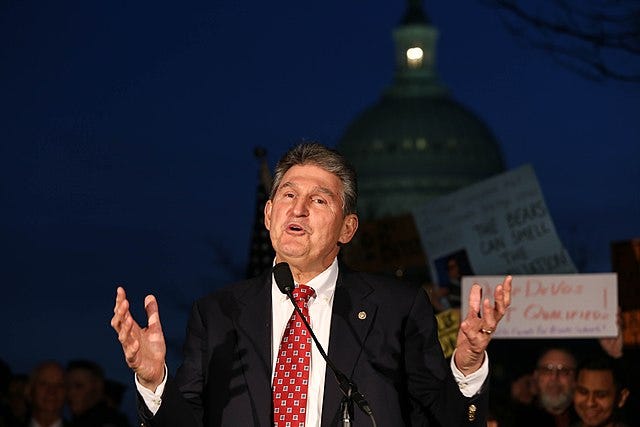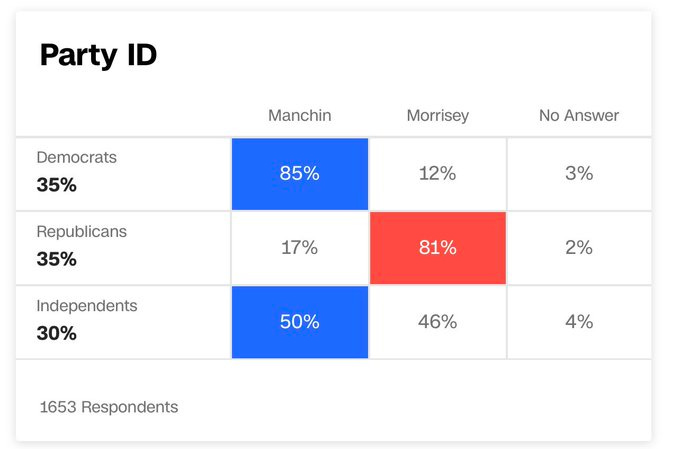The Myth of Joe Manchin
The image of Joe Manchin as a rational, center-right politician serves the media's narrative well. But it's a total myth.
The second Georgia sent two Democrats to the Senate—handing Democrats a total of 50 seats—Joe Manchin was going to be a problem. Democrats would now enter Biden’s presidency with control of all three branches of government, but without any room for error. Any one Democratic Senator now had veto power over the entirety of President Biden’s agenda, which is a problem when one of your members is from West Virginia.
To date, there has been no better illustration of this conundrum than last weekend, when Manchin, the Democrat from West Virginia (pop. 1.8 million), announced on Fox News that he will not support the current version Biden’s key legislative priority, the multi-trillion dollar social spending package referred to as Build Back Better.
If you’ve heard about this, you’ve also probably heard the oft-cited rationale for Manchin’s decision: that he is a “red-state Senator,” and red-state Senators can’t support lofty welfare bills. And sure, it makes sense: Manchin’s home state voted for Donald Trump by a 40 point margin. A Democrat has no business representing deep-red West Virginia, and the party should be glimmering with joy to even have that seat.

The problem with this narrative is it that it really doesn’t make any sense. It ignores the fact that Manchin, despite being from a deep-red state, is still a Democrat, and Democrats who are interested in winning reelection usually aren’t exactly thrilled to throw cold water on a hugely popular Democratic priority. It also ignores Manchin himself, who has given every indication that he is far from a good-faith political actor. Nonetheless, the narrative of Manchin as a rational, center-right actor being harassed by the radical left continues to chug along—much to the political establishment’s delight.
Reminder: Joe Manchin is a Democrat
Being an elected member of the Democratic Party isn’t just a label next to your name during TV interviews. It ties you to an agenda, a brand, a party leadership, a fundraising apparatus, and more. Most importantly, it identifies you to voters, most of whom aren’t tuned in to the day-to-day, 24 hour news cycle.
And here’s the reality with Manchin, as with any Democrat—he wins by getting Democrats to vote for him, not by winning Independents or cross-over Republicans. Take Manchin’s last reelection effort, in 2018. Democrats and Republicans both made up 35% of the electorate. Manchin won 85% of Democrats and just 17% of Republicans. Manchin won independents, who made up 30% of the electorate, by just 4 points.
There are obviously a ton of variables here, but the underrated fact about Manchin is that he depends on Democrats probably more than any other elected member of his party. Chuck Schumer, for example, can afford to lose far more Democrats than Manchin, who is basically a dead man walking if he loses even a fraction of their support. So yes, winning Independents and some Republicans is important for Manchin. But that’s only because he wins by narrow margins, making every voter important. What sends Manchin to Washington is primarily Democrats, where he gets the bulk of his support by far. This fact is almost entirely ignored.
As Alex Pareene observed in The Atlantic, a straight-forward political calculation would leave you much less concerned about Manchin than, say, Mark Warner, a centrist Democrat from a safe seat who can afford to piss off Democrats:
A senator like Manchin has a fairly simple calculation to make: Do popular things and avoid doing controversial things. The challenge for liberals in Congress and the White House is to convince him that good things would be popular. Centrist Democrats in safer seats, on the other hand, want to do things they know would be unpopular (especially among Democratic voters) without being blamed for it.
The fact is, Build Back Better is widely popular in West Virginia, as it is nationwide. This alone should be more relevant than the fact that West Virginia voted for Donald Trump by a wide margin. The “red state Senator” theory simply doesn’t explain Manchin’s actions, but it is the dominant explanation peddled across the board.
So What’s Going On?
Days after Manchin announced he would not support Build Back Better, the New York Times released a stunning report about Manchin:
Mr. Manchin, who defied gale-force political headwinds in 2010 by running for the Senate on his opposition to President Barack Obama’s climate change legislation, killed a provision in Build Back Better that would have imposed stiff penalties on electric utilities that continued to burn coal and natural gas.
But even with the stick dropped from the House’s bill, West Virginia’s coal interests were working hard to kill off the measure’s carrot, a package of tax credits to make clean energy more financially competitive, and, by extension, struggling coal even less so. Their lobbyists talked frequently to Mr. Manchin.
The report goes on to chronicle Manchin’s cozy relationship with coal lobbyists, as well as their relentless effort to convince Manchin not to support Build Back Better and its ambitious climate provisions. The report reveals that Manchin went as far as to echo his lobbyists’ talking points in his statement rejecting the bill.
So let’s review what we have here: a popular climate and social spending bill supported by a majority of West Virginians is opposed by a man who owes his political success to Democrats, but who also just so happens to owe his personal wealth to the coal industry and is regularly meeting with their lobbyists. The “red state Senator” theory, far from being an obvious explanation, simply does not describe this result in any coherent way. There is, in fact, really only one conclusion to draw from this: that Manchin is far from the rational, center-right actor that he is often portrayed as, and is really a reckless, corrupt politician using the power of his office to enrich himself and his industry.
But instead of the Times story breaking the airwaves yesterday, a different narrative took over. An op-ed in The Hill, citing unnamed sources, claimed that the real reason Manchin opposed Build Back Better is because of a statement the White House released blaming Joe Manchin for a delay in negotiations over the bill. Manchin apparently was incensed by this act of “incivility,” and that alone squashed the bill.
The story went viral, with a featured spot atop the widely read POLITICO Playbook newsletter (the Times story, published the same morning, wasn’t mentioned). It’s not hard to see why. The view of Manchin as a rational, center-right politician feuding with the Democratic Party plays directly into the dominant political media narrative of the day: that progressives are pushing the Democratic Party too far left, leading to a surge in support for the GOP. This allows the rough-and-tumble DC press approach to thrive without the need to confront the thorny issues the media likes to avoid: namely, corruption and the radicalism of the right.
The truth is, the mainstream media needs its Joe Manchins. It needs politicians who create intra-party drama, who lend credibility to the right and fill the vacuum created by the surging fascist base of the Republican Party. The media would much rather write about the disarray of the Democratic Party and the coming Republican backlash to progressive overreach than the brazen corruption that has led Manchin to abandon his constituents, or the abject failure of the Republican Party to present any solutions whatsoever for our climate crisis, or child poverty, or rising drug prices.
Joe Manchin, in the media’s eyes, stands for the proposition that the two political party’s are both on edge, and the real Americans are sitting in the middle, grasping for reason. But that Joe Manchin doesn’t exist, and we will never have a true picture of our political reality until the myth is put to rest.



